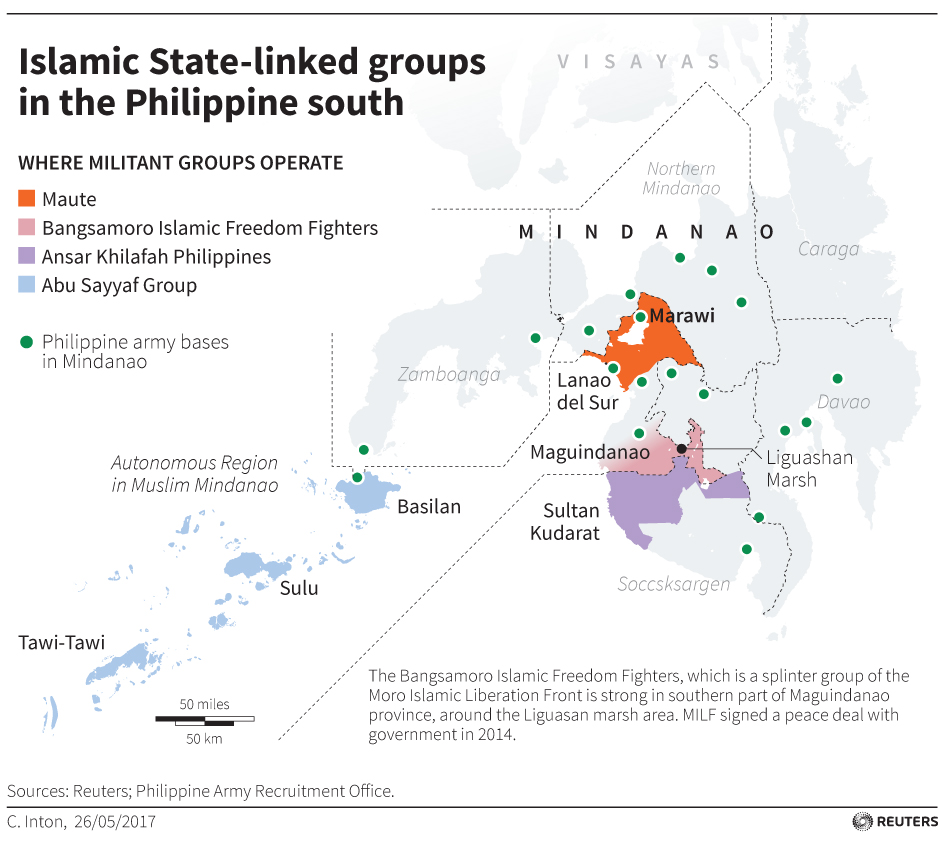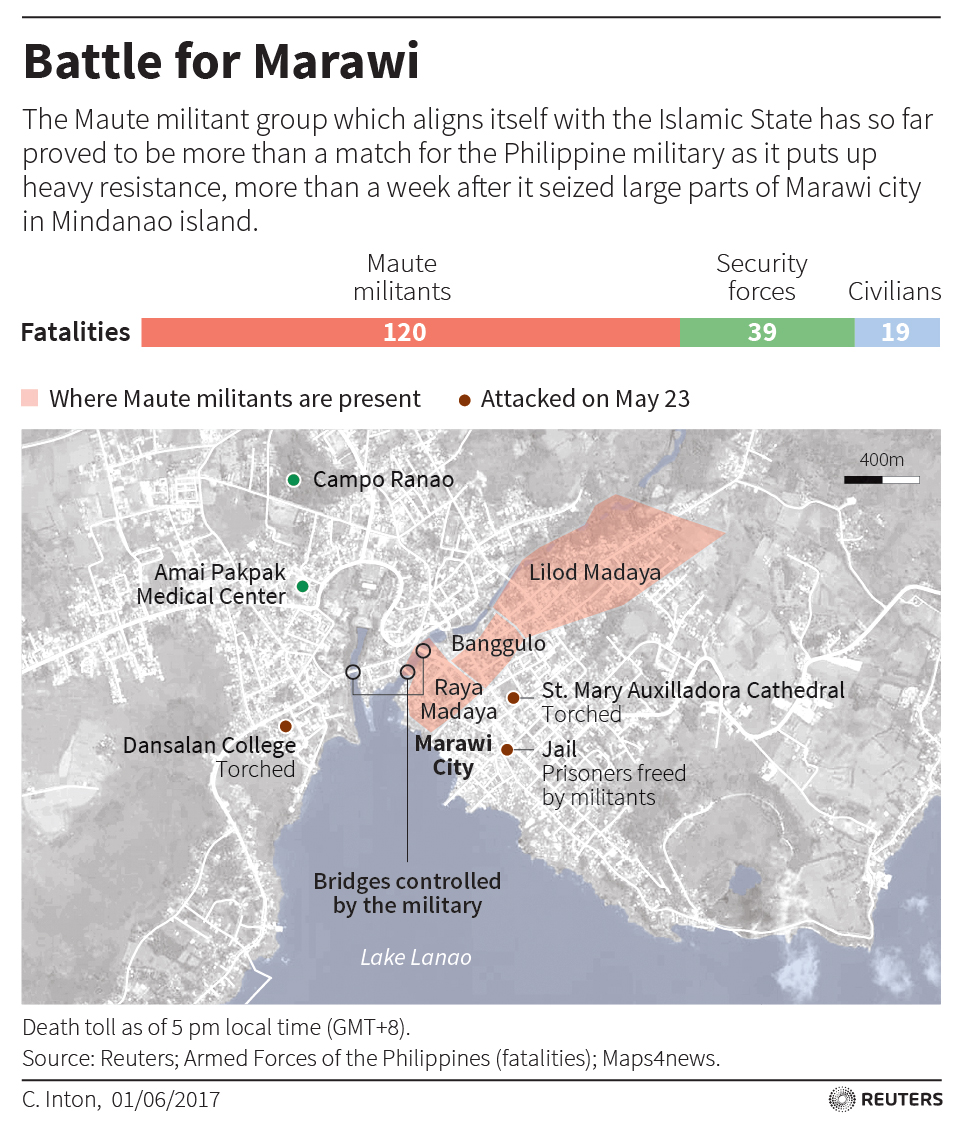
By Neil Jerome Morales and Simon Lewis
MARAWI CITY, Philippines (Reuters) – Fighting in Marawi City in the southern Philippines entered its fourth week on Tuesday with military officials conceding that troops were struggling to loosen the grip of Islamist fighters on downtown precincts despite relentless bombing.
Military spokesman Brigadier General Restituto Padilla said the urban terrain was hampering the army’s progress because the rebels had hunkered down in built-up neighborhoods, many of them with civilians they had taken as human shields.
Hundreds of other civilians were still trapped in the ruins of the town and – facing capture, starvation or bombardment from above – several have braved sniper fire to dash across a bridge to safety. Some were shot dead, a few made it alive.
Asked when the fighting would end, Padilla said: “I can’t give you an estimate because of compounding developments faced by ground commanders.”
The military had set Monday, the Philippines’ independence day, as a target date to flush out the militants, both local and foreign fighters who have pledged allegiance to Islamic State.
Flags were raised at ceremony in the town on the insurgency-plagued island of Mindanao, but heavy gunfire resumed early on Tuesday, and the military continued to target the militants with mortars and helicopter-mounted machineguns.
President Rodrigo Duterte, who declared martial law in Mindanao on May 23 – hours after several hundred fighters overran parts of the town and tried to seal it off to create an Islamic caliphate – did not show at any independence day events.
Duterte is best known for a brutal war on drugs since he took office a year ago, and he has suggested that funding for the Islamist militants came from the narcotics trade.
Some media reports highlighted the absence of the president at a time of serious conflict, but a spokesman said he was tired and needed to rest.
The Philippines has been fighting twin insurgencies from Maoist-led rebels and Muslim separatists in the south for nearly 50 years. Critics say military action is not enough to bring peace to a region that has long suffered from political neglect and poverty.
‘PURE PROPAGANDA’
The seizure of Marawi has alarmed Southeast Asian nations which fear Islamic State – on a backfoot in Iraq and Syria – is trying to set up a stronghold on Mindanao that could threaten their region.
The ultra-radical group’s news agency, Amaq, said the military in the largely Christian Philippines had “completely failed” to take back Muslim-majority Marawi.
“Islamic State fighters are spread in more than two-thirds of Marawi and tighten the chokehold on the Philippine army that is incapable of maintaining control of the situation,” it said.
Padilla branded the Amaq report “pure propaganda”.
Responding to the report, Lieutenant General Carlito Galvez, head of military command in Western Mindanao, told Reuters the militants controlled 20 percent of the town.
That is at least twice the area that the military had given a week ago, when it had said the rebels were holed up in a sliver of urban terrain equal to 10 percent and shrinking.
Almost the entire population of about 200,000 fled after the militants tried to overrun it, but the military believes that beyond the checkpoints now fencing off its main roads there are still some 300-600 civilians trapped or being held hostage.
Padilla said about 100 militants were still fighting, down from the estimated 400-500 who stormed the town.
Former military chief Rodolfo Biazon told ABC-CBN television on Monday that the government seemed to be struggling to control the situation because rebel forces could move freely in an out of the town, raising the prospect of reinforcements.
“Marawi has porous boundaries. You see them in one place of Mindanao today, you see them in another place tomorrow,” said Biazon, also a former legislator.
As of Tuesday, the number of security forces and civilians who had died in the battle for Marawi officially stood at 58 and 26, respectively. The death toll of militants was put at 202.
Islamic State’s Amaq news agency said that at least 200 government troops had been killed and many had abandoned their posts, leaving behind weapons that were seized by the militants.
It released a video showing the insurgents fighting and what it said was the execution of six Christians who were shot simultaneously in the back of the head. Reuters was not able to independently confirm the authenticity of the video.
At dawn on Tuesday, five police officers and five Christian civilians ran through the city’s commercial district to reach a government-controlled area on the Agus River’s west bank.
The military said that, in another incident, the insurgents knocked on the door of a house where 18 people were hiding. They escaped through a back door, but five were shot dead, eight were captured and only five made it to safety at the river.
(For graphic on Islamic State-linked groups in the Philippines south, click: tmsnrt.rs/2rYIHTj)
(For graphic on battle of Marawi, click: tmsnrt.rs/2qBkSPk)
(Additional reporting by Karen Lema and Manuel Mogato in MANILA; Writing by John Chalmers; Editing by Robert Birsel)











